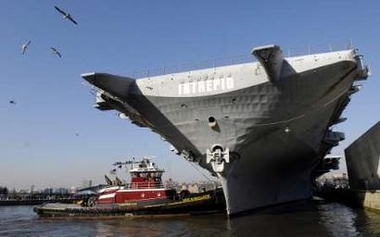Historic Aircraft Carrier USS Intrepid Stuck In The Mud
After 24 years at the same Hudson River pier, the legendary aircraft carrier USS Intrepid was inched out of its berth by powerful tugboats on Monday — but the trip never got under way because it got stuck in the mud as the tide went down. The mission was scrubbed for the day at around 10:30 a.m., according to Dan Bender, a Coast Guard spokesman. There was no immediate word when the effort would resume. Six powerful tugboats were guiding the massive vessel out of its berth after crew members symbolically cast off a mooring line. Helicopters flew overhead and police, Coast Guard and other ships were gathered on the river. Ship horns blared and a police band played. But the Intrepid's giant propellers got stuck in the mud as the tugboats strained to move the behemoth. It eventually began inching backward out of its berth, but moved only a few feet. "We knew it was not going to come out like a cruise ship," said Matt Woods, the Intrepid Sea, Air & Space Museum's vice president for operations. The legendary aircraft carrier is being moved to New Jersey for a $60 million overhaul. Monday's departure was timed to take advantage of yearly high tide so the tugs could pull the 27,000-ton ship, which no longer generates its own power, out of the slip where it has rested in up to 17 feet of mud. Removal of 600 tons of water from the Intrepid's ballast tanks gave the ship added buoyancy, and dredges removed 15,000 cubic yards of mud to create a channel from dockside to deeper water. "We were able to move her 15 feet, and then she came to a halt.
Ship horns blared and a police band played. But the Intrepid's giant propellers got stuck in the mud as the tugboats strained to move the behemoth. It eventually began inching backward out of its berth, but moved only a few feet. "We knew it was not going to come out like a cruise ship," said Matt Woods, the Intrepid Sea, Air & Space Museum's vice president for operations. The legendary aircraft carrier is being moved to New Jersey for a $60 million overhaul. Monday's departure was timed to take advantage of yearly high tide so the tugs could pull the 27,000-ton ship, which no longer generates its own power, out of the slip where it has rested in up to 17 feet of mud. Removal of 600 tons of water from the Intrepid's ballast tanks gave the ship added buoyancy, and dredges removed 15,000 cubic yards of mud to create a channel from dockside to deeper water. "We were able to move her 15 feet, and then she came to a halt. We tried to add more power with another tugboat but we couldn't wiggle her free," said Jeffrey McAllister, the chief pilot of the tugboat operation. "We were missing our open window. We had to give up because the tides were going down," he added. "She was moving, we were hopeful, she started to creep along but then she stopped." "It was very disappointing," said McAllister. The World War II flattop, which also served in the Korean and Vietnam wars, will return in 2008 to a rebuilt pier, to resume its mission as the Intrepid Sea, Air & Space Museum, drawing hundreds of thousands of tourists a year. Retired Rear Adm. J. Lloyd "Doc" Abbot, 80, who served two years as Intrepid's skipper in 1960-62, was named honorary commander for the day. "It was the best job I ever had," Abbot said Monday, standing once again on the ship's deck. "Intrepid had a soul of her own. How can a hunk of iron have a soul, you may ask. But I loved her. She kept me safe and at times I kept her safe." Hector Giannesca stood on the flight deck Monday morning. "On March 25, 1944, I was standing on this deck almost in the exact spot as today when a kamikaze crashed into the deck and killed 79 of my shipmates. I was spared," he said.
We tried to add more power with another tugboat but we couldn't wiggle her free," said Jeffrey McAllister, the chief pilot of the tugboat operation. "We were missing our open window. We had to give up because the tides were going down," he added. "She was moving, we were hopeful, she started to creep along but then she stopped." "It was very disappointing," said McAllister. The World War II flattop, which also served in the Korean and Vietnam wars, will return in 2008 to a rebuilt pier, to resume its mission as the Intrepid Sea, Air & Space Museum, drawing hundreds of thousands of tourists a year. Retired Rear Adm. J. Lloyd "Doc" Abbot, 80, who served two years as Intrepid's skipper in 1960-62, was named honorary commander for the day. "It was the best job I ever had," Abbot said Monday, standing once again on the ship's deck. "Intrepid had a soul of her own. How can a hunk of iron have a soul, you may ask. But I loved her. She kept me safe and at times I kept her safe." Hector Giannesca stood on the flight deck Monday morning. "On March 25, 1944, I was standing on this deck almost in the exact spot as today when a kamikaze crashed into the deck and killed 79 of my shipmates. I was spared," he said. The carrier's $60 million refurbishment will include opening up more interior spaces to the public, upgrading its exhibits and a bow-to-stern paint job in naval haze-gray. Pier 86 will also be completely rebuilt in the Intrepid's absence. The city is contributing $17 million, the state $5 million, the federal government $36 million, plus $2 million in private funds. The Intrepid, launched in 1943, is one of four Essex-class carriers still afloat six decades after spearheading the naval defeat of Japan in the Pacific. It survived five kamikaze suicide attacks and lost 270 crewmen in battle. Doomed to the scrap heap, it was purchased in 1981 to be turned into a museum by real estate developer Zachary Fisher. It became one of New York's major tourist attractions, the Intrepid Sea, Air & Space Museum, drawing some 700,000 visitors a year. It also supports a Fallen Heroes Fund that has provided $14 million to aid families of service members killed and wounded in the line of duty and built a $35 million advanced training facility for disabled veterans.
The carrier's $60 million refurbishment will include opening up more interior spaces to the public, upgrading its exhibits and a bow-to-stern paint job in naval haze-gray. Pier 86 will also be completely rebuilt in the Intrepid's absence. The city is contributing $17 million, the state $5 million, the federal government $36 million, plus $2 million in private funds. The Intrepid, launched in 1943, is one of four Essex-class carriers still afloat six decades after spearheading the naval defeat of Japan in the Pacific. It survived five kamikaze suicide attacks and lost 270 crewmen in battle. Doomed to the scrap heap, it was purchased in 1981 to be turned into a museum by real estate developer Zachary Fisher. It became one of New York's major tourist attractions, the Intrepid Sea, Air & Space Museum, drawing some 700,000 visitors a year. It also supports a Fallen Heroes Fund that has provided $14 million to aid families of service members killed and wounded in the line of duty and built a $35 million advanced training facility for disabled veterans.
 Ship horns blared and a police band played. But the Intrepid's giant propellers got stuck in the mud as the tugboats strained to move the behemoth. It eventually began inching backward out of its berth, but moved only a few feet. "We knew it was not going to come out like a cruise ship," said Matt Woods, the Intrepid Sea, Air & Space Museum's vice president for operations. The legendary aircraft carrier is being moved to New Jersey for a $60 million overhaul. Monday's departure was timed to take advantage of yearly high tide so the tugs could pull the 27,000-ton ship, which no longer generates its own power, out of the slip where it has rested in up to 17 feet of mud. Removal of 600 tons of water from the Intrepid's ballast tanks gave the ship added buoyancy, and dredges removed 15,000 cubic yards of mud to create a channel from dockside to deeper water. "We were able to move her 15 feet, and then she came to a halt.
Ship horns blared and a police band played. But the Intrepid's giant propellers got stuck in the mud as the tugboats strained to move the behemoth. It eventually began inching backward out of its berth, but moved only a few feet. "We knew it was not going to come out like a cruise ship," said Matt Woods, the Intrepid Sea, Air & Space Museum's vice president for operations. The legendary aircraft carrier is being moved to New Jersey for a $60 million overhaul. Monday's departure was timed to take advantage of yearly high tide so the tugs could pull the 27,000-ton ship, which no longer generates its own power, out of the slip where it has rested in up to 17 feet of mud. Removal of 600 tons of water from the Intrepid's ballast tanks gave the ship added buoyancy, and dredges removed 15,000 cubic yards of mud to create a channel from dockside to deeper water. "We were able to move her 15 feet, and then she came to a halt. We tried to add more power with another tugboat but we couldn't wiggle her free," said Jeffrey McAllister, the chief pilot of the tugboat operation. "We were missing our open window. We had to give up because the tides were going down," he added. "She was moving, we were hopeful, she started to creep along but then she stopped." "It was very disappointing," said McAllister. The World War II flattop, which also served in the Korean and Vietnam wars, will return in 2008 to a rebuilt pier, to resume its mission as the Intrepid Sea, Air & Space Museum, drawing hundreds of thousands of tourists a year. Retired Rear Adm. J. Lloyd "Doc" Abbot, 80, who served two years as Intrepid's skipper in 1960-62, was named honorary commander for the day. "It was the best job I ever had," Abbot said Monday, standing once again on the ship's deck. "Intrepid had a soul of her own. How can a hunk of iron have a soul, you may ask. But I loved her. She kept me safe and at times I kept her safe." Hector Giannesca stood on the flight deck Monday morning. "On March 25, 1944, I was standing on this deck almost in the exact spot as today when a kamikaze crashed into the deck and killed 79 of my shipmates. I was spared," he said.
We tried to add more power with another tugboat but we couldn't wiggle her free," said Jeffrey McAllister, the chief pilot of the tugboat operation. "We were missing our open window. We had to give up because the tides were going down," he added. "She was moving, we were hopeful, she started to creep along but then she stopped." "It was very disappointing," said McAllister. The World War II flattop, which also served in the Korean and Vietnam wars, will return in 2008 to a rebuilt pier, to resume its mission as the Intrepid Sea, Air & Space Museum, drawing hundreds of thousands of tourists a year. Retired Rear Adm. J. Lloyd "Doc" Abbot, 80, who served two years as Intrepid's skipper in 1960-62, was named honorary commander for the day. "It was the best job I ever had," Abbot said Monday, standing once again on the ship's deck. "Intrepid had a soul of her own. How can a hunk of iron have a soul, you may ask. But I loved her. She kept me safe and at times I kept her safe." Hector Giannesca stood on the flight deck Monday morning. "On March 25, 1944, I was standing on this deck almost in the exact spot as today when a kamikaze crashed into the deck and killed 79 of my shipmates. I was spared," he said. The carrier's $60 million refurbishment will include opening up more interior spaces to the public, upgrading its exhibits and a bow-to-stern paint job in naval haze-gray. Pier 86 will also be completely rebuilt in the Intrepid's absence. The city is contributing $17 million, the state $5 million, the federal government $36 million, plus $2 million in private funds. The Intrepid, launched in 1943, is one of four Essex-class carriers still afloat six decades after spearheading the naval defeat of Japan in the Pacific. It survived five kamikaze suicide attacks and lost 270 crewmen in battle. Doomed to the scrap heap, it was purchased in 1981 to be turned into a museum by real estate developer Zachary Fisher. It became one of New York's major tourist attractions, the Intrepid Sea, Air & Space Museum, drawing some 700,000 visitors a year. It also supports a Fallen Heroes Fund that has provided $14 million to aid families of service members killed and wounded in the line of duty and built a $35 million advanced training facility for disabled veterans.
The carrier's $60 million refurbishment will include opening up more interior spaces to the public, upgrading its exhibits and a bow-to-stern paint job in naval haze-gray. Pier 86 will also be completely rebuilt in the Intrepid's absence. The city is contributing $17 million, the state $5 million, the federal government $36 million, plus $2 million in private funds. The Intrepid, launched in 1943, is one of four Essex-class carriers still afloat six decades after spearheading the naval defeat of Japan in the Pacific. It survived five kamikaze suicide attacks and lost 270 crewmen in battle. Doomed to the scrap heap, it was purchased in 1981 to be turned into a museum by real estate developer Zachary Fisher. It became one of New York's major tourist attractions, the Intrepid Sea, Air & Space Museum, drawing some 700,000 visitors a year. It also supports a Fallen Heroes Fund that has provided $14 million to aid families of service members killed and wounded in the line of duty and built a $35 million advanced training facility for disabled veterans.



















<< Home